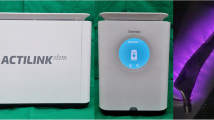Abstract
The application of titanium plasma-spray coatings to Ti-6Al-4V orthopedic implants results in a dramatic decrease in high-cycle fatigue performance. The better bonding of the plasma sprayed and heat-treated implants results in a lower high-cycle fatigue strength. Therefore, the use of plasma-spray textured coatings on implants must be considered with caution.
Similar content being viewed by others
References
H.C. Amstutz, K.L. Markolf, G.M. McNeice, and T.A. Gruen, “Loosening of Total Hip Components: Cause and Prevention,” The Hip: Proceedings of the Fourth Open Scientific Meeting of the Hip Society, ed. C.V. Mosby (St. Louis, MO: The Hip Society, 1976), pp. 102–116.
T.A. Gruen, G.M. McNeice, and H.D. Amstutz, “Modes of Failure: Cemented Stem—Type Femoral Components—A Radiographic Analysis of Loosening,” Clinical Orthopaedics, 141 (1979), pp. 17–27.
H.G. Willert, J. Ludwig, and M. Semlitsch, “Reaction of Bone to Methacrylate After Hip Arthroplasty: A Long-Term Gross, Light Microscopic and Scanning Electron Microscopic Study,” J. Bone and Joint Surgery, 56A (1974), p. 1368.
M.D. Willert, “Tissue Reactions Around Joint Implants and Bone Cement,” Symposium on Arthroplasty of the Hip, ed. G. Chapcal (Stuttgart, Germany: Thieme, 1973), pp. 11–21.
T.S. Smith, “Rationale for Biological Fixation of Prosthetic Devices,” SAMPE Journal, 21(3) (May/June 1985).
C.A. Engh and J.D. Bobyn, “Biologic Fixation of Hip Prosthesis: A Review of the Clinical Status and Current Concepts,” Advances in Orthopaedic Surgery, 18 (1984), pp. 136–149.
J.P. Collier, F.E. Kennedy, M.B. Mayor, and C.O. Townley, “Stress Distribution in the Human Femur: The Role of Femoral Prosthesis Geometry and the Mechanics of Fixation,” Transactions, 30th Annual Meeting of the Orthopaedic Research Society (Atlanta, GA: Orthopaedic Research Society, 1984).
Dana C. Mears, Materials and Orthopaedic Surgery, p. 508.
Hahn, U.S. patent 3,665,123.
Zimmer Technical Documentation, “Fatigue and Porous Coated Implants” (Warsaw, IN: Zimmer, 1984).
U.S. Yue, R.M. Pillar, and G.C. Weatherly, “The Fatigue Strength of Porous Coated-Coated Ti-6Al-4V Implant Alloy,” J. Biomed Mater. Res., 18 (1984), pp. 1043–1058.
D. Wolfarth, M. Filiaggi, and P. Ducheyne, “Parametric Analysis of Interfacial Stress Concentrations in Porous Coated Implants,” J. Appl. Biomaterials, 1 (1990), pp. 3–12.
D. Wolfarth and P. Ducheyne, “Effect of Porous Coating Geometry on Interfacial Stress Under a Shear Load,” J. Biomed. Mater. Res., 27 (1993), pp. 1585–1590.
M. Semlitsch and B. Panic, Ten Years of Experience with Test Criteria for Fracture-Proof Anchorage Stems of Artificial Hip Joints (Medizinaltechnik, 1983).
Author information
Authors and Affiliations
Rights and permissions
About this article
Cite this article
Smith, T. The effect of plasma-sprayed coatings on the fatigue of titanium alloy implants. JOM 46, 54–56 (1994). https://doi.org/10.1007/BF03222560
Published:
Issue Date:
DOI: https://doi.org/10.1007/BF03222560




